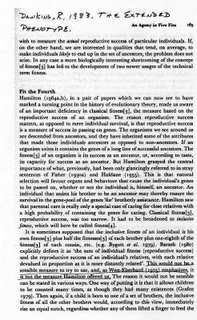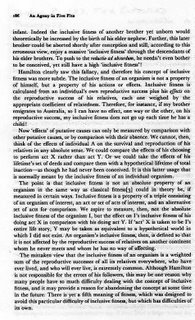Tuesday, October 31, 2006
Ammunition for Evolutionists
Yes, I'm back. Sorry that I've been delinquent in my blogging duites. I won't let it happen again. And I will read the other blogs you guys have posted while I've been on sabbatical. They look really interesting.
Today, a student in our Comparative Animal Behavior class asked Todd and I if we had seen a film called "Icons of Evolution." The student (who is actually very bright) told us that she just viewed this documentary where scientists were discussing some of the problems with evolution by natural selection. Our first response was that she wasted her time with religious propaganda. She then told us that she's atheist and that the film made no mention of God or religion or even Intelligent Design. And she kept stressing the supposed scientific merit of the documentary. Of course, Todd and I didn't think that this film was a legitimate threat, but we promised the student that we would check it out.
Well, our suspicions were correct. The film, which was first a book by the same title, is the work of a creationist, Jonathan Wells. But this guy isn't you're ordinary creationist. He's got a PhD in biology and he's pretty cleaver because his book/film attacks evoluion from a (supposedly) scientific perspective. Check out some of the questions below. These are questions that Wells encourages people to ask their biology teachers, to stump them.
Q: ORIGIN OF LIFE. Why do textbooks claim that the 1953 Miller-Urey experiment shows how life's building blocks may have formed on the early Earth -- when conditions on the early Earth were probably nothing like those used in the experiment, and the origin of life remains a mystery?
Q: DARWIN'S TREE OF LIFE. Why don't textbooks discuss the "Cambrian explosion," in which all major animal groups appear together in the fossil record fully formed instead of branching from a common ancestor -- thus contradicting the evolutionary tree of life?
Q: HOMOLOGY. Why do textbooks define homology as similarity due to common ancestry, then claim that it is evidence for common ancestry -- a circular argument masquerading as scientific evidence?
Q: VERTEBRATE EMBRYOS. Why do textbooks use drawings of similarities in vertebrate embryos as evidence for their common ancestry -- even though biologists have known for over a century that vertebrate embryos are not most similar in their early stages, and the drawings are faked?
Q: ARCHAEOPTERYX. Why do textbooks portray this fossil as the missing link between dinosaurs and modern birds -- even though modern birds are probably not descended from it, and its supposed ancestors do not appear until millions of years after it?
Q: PEPPERED MOTHS. Why do textbooks use pictures of peppered moths camouflaged on tree trunks as evidence for natural selection -- when biologists have known since the 1980s that the moths don't normally rest on tree trunks, and all the pictures have been staged?
Of course, the three of us can give an answer to many of these questions, but image a high school biology teacher trying to respond to some of these! And as further proof that this tactic of scientifically debating evolutionary theory can be effective comes from the fact the bright student in our class was really interested in our responses to these questions.
So as the title of this blog suggests, I've got ammunition for my fellow evolutionists. This link (http://www.natcenscied.org/icons/), which is sponsored by the National Center for Science Education, provides answers to Wells's questions. Another really great resource Todd found is a review of Wells's book that appeared in Nature (http://chem.tufts.edu/AnswersInScience/Coyne-IconsReview.htm). Read this, if you've got time.
So now you're armed.
Monday, October 23, 2006
"I care about what's true, not about what's comforting"--more Dawkins
Check it out here.
Sunday, October 22, 2006
Dawkins on inclusive fitness
Check it out, it's worth a read: (click to enlarge)


Friday, October 20, 2006
Does God exist. Go.
Wednesday, October 18, 2006
Groovy UV (so cheesy)
Dark nests and egg colour in birds: a possible functional role of ultraviolet reflectance in egg detectability
Abstract:
Owing to the conspicuousness of ultraviolet (UV) colour in dark environments, natural selection might have selected UV egg coloration because it would enhance egg detectability by parents in murky nests. Here, we tested this hypothesis by using comparative and experimental approaches. First, we studied variation in egg coloration of 98 species of European passerines measured using UV–visible reflectance spectrometry (300–700nm) in relation to nesting habits. Analyses based on raw data and controlling for phylogenetic distances both at the species and the family levels revealed that hole-nester species produced eggs with higher UV reflectance than those nesting in open habitats. The experimental approach consisted of the manipulation of UV reflectance of the experimental eggs introduced outside the nest-cup of the hole-nester spotless starling Sturnus unicolor and the study of the retrieval of these eggs. Ultraviolet-reflecting eggs (controls) were more frequently retrieved to the nest-cup than non-reflecting (–UV) eggs. These results were not due to ‘–UV’ eggs being recognized by starlings as parasitic because when a parasitic egg is detected, starlings removed it from the nest-box. Therefore, these results are consistent with the hypothesis that UV egg colours are designed to provide highly detectable targets for parent birds in dark nest environments.
Sunday, October 15, 2006
Interesting NAS conference
Here's the link.
Thursday, October 12, 2006
MILG--Mother I'd like to Guard
Did you see this theoretical paper in Proceedings that models when offspring should "mother guard" to protect their inclusive fitness interests? Pretty intriguing! Any thoughts on how/if this might work in humans? See the abstract below.
Mother guarding: how offspring may influence the extra-pair behaviour of their parents
Justin A. Welbergen* and Suhel Quader
In this paper we propose a novel form of social control of mate choice. Through mother guarding, offspring can help in protecting the paternity of their father by preventing their mother from engaging in extra-pair matings. We present a model that predicts the circumstances under which mothers should be selected to seek or avoid extra-pair matings, and existing offspring should be selected to prevent or promote such matings. In its simplest form, our model shows that offspring are selected to mother guard as long as the viability of extra-pair young is less than twice that of within-pair young; when the relative viability is greater, offspring are selected to promote extra-pair mating by their mother. If the existing offspring are not necessarily sired by their mother’s social mate, then the potential for conflict is further reduced. We also consider whether offspring have an interest in the extra-pair reproduction of their fathers. We show that when the costs of the father’s infidelity to the mother’s brood are high, existing offspring are selected to prevent extra-pair mating by their father; when such costs are low, offspring are selected to promote extrapair mating by their father. In principle, our model applies to all species where offspring show delayed dispersal and where breeding pairs raise multiple broods or litters. This situation exists in, but is not limited to, the majority of cooperatively breeding species. The significance of this model with regard to our current understanding of the evolution of extra-pair behaviour in such species is discussed.
Thursday, October 05, 2006
Great minds think alike????
Did you know he's not alone in this???
Apparently Robert Trivers identifies more with black individuals than with white individuals. He used to be a member of the Black Panther party, he owns a home in Jamaica, he prefers all-black bars, and he owns some culture typical clothing (well a hat...but I couldn't describe it if I tried).
Anyway...maybe there's something to this? Perhaps it's true that great minds think alike? Or maybe crazy minds? :-P
Tuesday, October 03, 2006
SPSP pre-conference
Sunday, October 01, 2006
F mate prefs among the Ache
Kim Hill: Achipura, what kind of man could get many women, what kind did women love, the kind who could easily find a wife?
Achipuragi: He had to be a good hunter.
KH: So if a man was a good hunter he could easily find a wife.
A: No, not just a good hunter. A good hunter could find a wife, but a man needed to be strong.
KH: When you say strong, do you mean a man who could beat up others in a club fight?
A: No, women don't like those men. Women don't like men who love to hit others. I mean a strong man. One who would walk far to hunt, one who would carry heavy loads. I mean a man who would work hard when everyone was tired, or build a hut when it was cold and rainy, a man who would carry his children and get firewood at night. I mean a man who was strong. A man who could endure and would not get tired.
KH: Did women love big men then (i.e., men of large body size)?
A: No, they would love a small man or a large man, but he had to be strong.
KH: What other men would be able to acquire a wife easily?
A: A man who was a "good man."
KH: What does that mean, "a good man"?
A: A good man is one who is handsome (attractive face). One whom women love. One who is nice and smiles and tells jokes. He is a man who is handsome. A "good man" is a man whom women love.